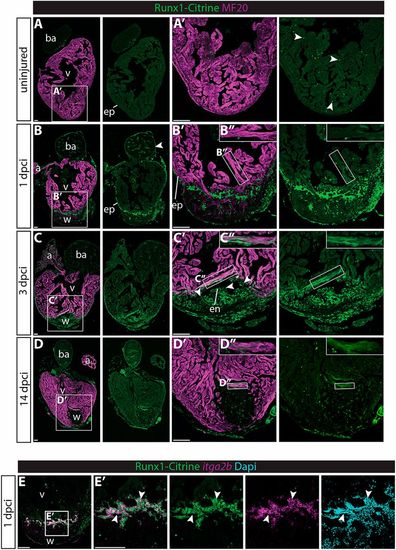
Runx1-Citrine becomes strongly expressed in the heart after cryo-injury. (A-D?) Immunohistochemistry for Runx1-Citrine (GFP antibody) and the myocardial marker MF20 at different time points after cryo-injury. (A,A?) Citrine expression in the uninjured hearts was confined to a small number of cells scattered around the heart (arrowheads). (B-B?) At 1?dpci, the epicardium was Citrine positive (arrowheads). Bright blood cells were visible within the wound and there was dim expression of Citrine overlapping with MF20 (B?). (C-C?) At 3?dpci, the epicardium, endocardium (arrowheads) and other wound cells were positive for Citrine. In addition, the myocardium in the border zone next to the wound was highly Citrine positive (C?). (D-D?) Expression of Citrine diminishes at 14?dpci but is still visible, especially in the myocardium (D?). (E,E?) In situ hybridisation for itga2b with immunohistochemistry for Runx1-Citrine and nuclear marker DAPI. Arrowheads indicate overlap of Runx1-Citrine with itg2b mRNA, indicating that thrombocytes are positive for Runx1-Citrine. a, atrium; ba, bulbus arteriosus; dpci, days post cryo-injury; en, endocardium; ep, epicardium; v, ventricle; w, wound. Scale bars: 100??m.
|

